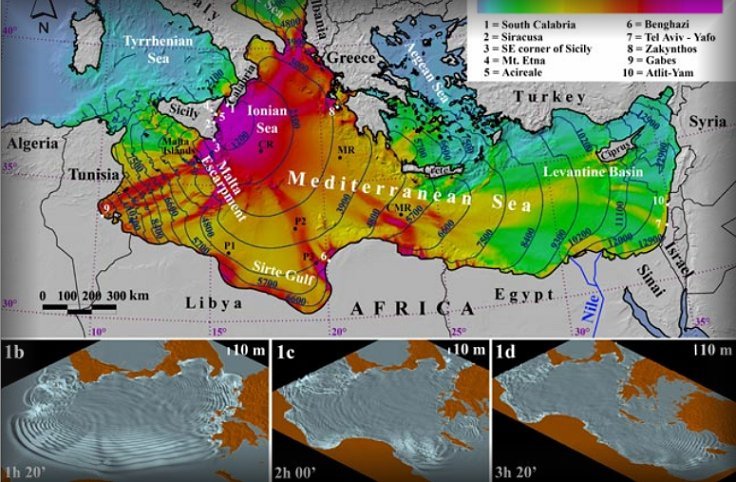
|
 From the Etna to the Levantine shore – an ancient tsunami? From the Etna to the Levantine shore – an ancient tsunami?
December 2006, CIESM News |
| About 8,000 years ago the collapse of the eastern flank of Mt Etna in Sicily triggered a devastating tsunami that spread across the Mediterranean Sea, hitting distant shores within a few hours. A computer simulation of this ancient catastrophe now reveals its far-reaching effects.
_______________________
The occurrence of a tsunami which impacted the whole eastern Mediterranean in the early Holocene was numerically simulated in a recent study(1). The ancient tsunami modelled by scientists of the ‘Istituto Nazionale di Geofisica e Vulcanologia’ in Pisa (Italy) was triggered by a debris avalanche from Mt Etna (Sicily, Fig. 1a/no4). With a volume of about 25 km3, i.e. enough material to cover the entire Sicily with a one meter layer of debris, the massive landslide crashed into the Ionian Sea in the order of minutes. The resulting tsunami waves were able to destabilize soft marine sediments and to trigger sediment flows across the Ionian seafloor.
While evidence from this tsunami event is lacking onshore, evidence of large submarine landslide deposits offshore from Mt Etna were revealed by collecting high resolution seismic data(2). Spatially these deposits are consistent with the eastern flank collapse of the volcano and computer simulations indicate that this collapse occurred as a rapid and catastrophic event. The generated tsunami waves affected low lying coastal regions within the eastern Mediterranean Basin, including the coasts of Southern Europe, North Africa and Asia Minor. Over the last 8.000 years, however, the sea level increased about ten meters compromising the identification of in situ tsunami deposits and of near-coast topographic/bathymetric variables.
In the present study(1), the researchers also linked the sudden abandonment of the village of Atlit-Yam (Israel, Fig. 1a/no10) to the ancient Etna tsunami event. This submerged (10 meters below sea-level), well preserved Pre-Pottery Neolithic settlement is situated a few hundred meters off the present-day shoreline of Israel. Evidence of a hasty evacuation was found, e.g. when zooarchaeologists studied this site some years ago(3): a pile of fish had been gutted, processed in a size-dependent manner, and then stored for future consumption or trade. Such findings cannot simply be explained by the Holocene sea level rise in the Mediterranean.
|

|
|
|
Figure 1.
Maximum wave crest heights predicted by a computer simulation of an ancient tsunami affecting the whole eastern Mediterranean Basin (1a). The blue lines are arrival times of the first tsunami waves.
Furthermore, tsunami wave fields are shown at time steps of 1h20’ (1b), 2h (1c) and 3h20’ (1d) after a debris avalanche enters the sea. The white vertical bars provide the tsunami wave height scale.
A number of effects induced by local and regional topography can be observed. For example, between Africa and Crete, as a result of part of the wave front rebounding off of the African coast, the waves are observed as crushing together (Source: Pareschi et al., 2006a).
|
Debris avalanches and minor eruptions on Mt Etna still occur today, but so far nothing approaching the magnitude of this ancient event. If a comparable tsunami would be generated today, southern Italy would be inundated within the first 15-20 minutes. The western coast of Greece (Zakynthos, Fig. 1a/no8) would be reached by the waves in about an hour. Half an hour later the North African city of Benghazi (Fig. 1a/no6) and other towns in the Gulf of Sirta would be hit. Within three and a half hours, the tsunami waves would have traversed the entire eastern Mediterranean Sea to reach the coasts of eastern Turkey, Syria, Lebanon and Israel.
If such an event occurred today, it would have a disastrous impact on the coastal zones concerned, most of them densely populated.
_______________________
|
(1) Pareschi M.T., Boschi E. and Favalli M., 2006a. Lost tsunami. Geophys. Res. Lett., 33, L22608, doi:10.1029/2006GL027790.
(2) Pareschi M.T., Boschi E., Mazzarini F. and Favalli M., 2006b. Large submarine landslides offshore Mt Etna. Geophys. Res. Lett., 33, L13302, doi:10.1029/2006GL026064.
(3) Zohar I., Dayan T., Galili E. and Spanier E., 2001. Fish processing during the early holocene: a taphonomic case study from coastal Israel. J. Archaeol. Sci., 28(10): 1041-1053.
____________________________________________________
|
- For information on sea level monitoring and tsunamis in the Mediterranean consult the CIESM/ IOC MedGLOSS Program.
- During the forthcoming 38th CIESM Congress in Istanbul, April 2007 the issue of tsunami monitoring in the Mediterranean Sea will be discussed during Panel no 7 “Warning signals”.
|
|



